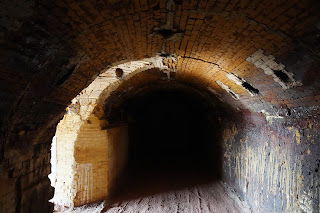Natural stone is rare and expensive in the Netherlands. On the other hand plenty of clay is available along the many arms in the river delta of Rhine, Maas and Schelde. Therefore traditionally Dutch houses are built from brick. Nut also castles, fortresses, bridges and factories were built from bricks. Consequently numerous brickworks popped up in places along the shores of the rivers where suitable deposits of clay were available. The coal necessary for burning the bricks could be brought in and the products shipped out on barges. In the little village of Druten alone there were 13 brickworks.
The Waal floodplains near Nijmegen. In the background the chimney of a former brickworks
Modern brickworks and concrete factories have taken over from the traditional coal fired plants. Few survive today as museum, and even less in working order. One is the Vogelensangh brickworks in Deest. This factory was built in 1918-1919 and bricks are still baked in much the same way as 100 years ago. The factory consists of a press building and a coal-fired ring oven, the cream of the crop at the time.
The rectangular ringoven in Vogelensangh
While the clay for the bricks formerly was dug from the nearby fields and dumped on the clay mound to let it "rot" for several months it is now delivered by truck. It is not scraped off by hand and transported in wheelbarrows to the press building but a excavator puts it on a conveyer belt. There it is mixed in a clay mill powered by electricity instead of a steam engine. The mixed clay then is put into the mold containers. The employees adjust the size of the mold to be able to make custom-made stones for every project.
Narrow gauge Jung Diesel engine with trucks
After shaping in the molds the stones are taken to the drying room to dry for at least 6 days at a temperature of 50 to 75 degrees. The hot air used for drying is supplied from the ring oven. The drying room replaced the original huts, where it took weeks to dry the raw material by wind.
The pipe bringing hot air from the ringoven to the drying shed
end of the ringoven
The bricks are baked in the only coal-fired ring kiln left in the Netherlands. Pallets of bricks are wheeled into the coolest of the 20 gates. The fire wanders from chamber to chamber in the ring kiln in ten days where the bricks are fired at a temperature of about 1060 degrees Celsius. To achieve that temperature the stokers throw coal into the oven through the stoke holes day and night.
Inside an oven chamber ready to be filled with raw bricks
After cooling the bricks can be removed from the kiln. The bricks are now manually sorted by color to create a unique selection for each project. Stones that were closer to the fire are bluer and stones that were less close to the fire are red in color.
Door to the open chamber of the ringoven
Sealed oven chamber
When you cycle along the many arms of the Rhine Maas Schelde river delta you come across the remains of bricks works which did not survive. Strangely enough the most delicate part of the structure, the chimney, seems to survive the longest. Sometimes more of the buildings survive to be used for other purposes.
Abandoned brickworks at Druten
Of course bricks still have to be produced by modern plants. Only the chimney and the pallets of bricks give away the purpose of the character less modern buildings.
Leftover chimney of brickworks at Rossum
One of the structures that survives as a museum is de panoven nor far from Zevenaar. From 1850 to 1983, bricks were baked here using traditional methods. The round zigzag oven and the drying shed âre National Monuments List. With two other drying sheds turned into group accommodation and three restored drying sheds the brick factory is still completely intact and is maintained with great passion..
Circular ringoven and the former field railway in Panoven
Links:


















No comments:
Post a Comment